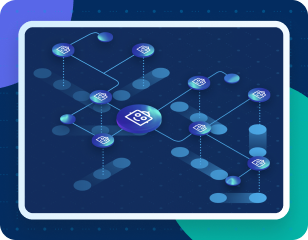We're currently experiencing issues with our forms. Our team is working fast to resolve the issue. Thank you for your patience and understanding.
What is Data Integration? A Complete Guide
When your data lives in too many places, it’s hard to get a clear picture of what’s really going on. Data integration helps by pulling everything together into one consistent view.
In this guide, you’ll learn what data integration is, why it matters, and how it can help your business work more efficiently and make better decisions.
What is data integration?
Data integration brings together information from different sources to create a consistent, unified view. It breaks down silos, fixes inconsistencies, and makes sure teams have access to reliable, up-to-date data. This foundation supports better analysis, stronger reporting, and more informed decisions.
When done well, data integration offers major advantages. It connects data across departments for a complete picture, improves data quality by removing errors and duplicates, and boosts efficiency through automation. With shared access to accurate data, teams can collaborate more effectively, respond faster, and uncover insights that give the business a competitive edge.
Key concepts in data integration
To understand how data integration works, it's helpful to look at the main concepts:
- Source systems: Data is typically spread across various platforms like databases, cloud applications, spreadsheets, or other systems.
- Extraction: The process begins by pulling data from these sources, whether it’s structured (like in databases) or unstructured (like text files).
- Transformation: Once extracted, the data is cleaned, formatted, and standardized to ensure consistency and usability. This may involve normalizing values, resolving duplicates, or enriching the data with additional context.
- Loading: The prepared data is then loaded into a central system, such as a data warehouse or data lake, where it can be accessed for reporting and analysis.
- Unified view: The goal is to present a single, coherent view of the data across the organization. This unified view enables cross-functional teams to collaborate more easily and make decisions based on the same information.
- Automation and tools: Data integration can be done manually, but it’s often automated using tools and platforms that support ETL (Extract, Transform, Load), ELT, data replication, and data virtualization.
How data integration works
Data integration isn’t just about moving data from one place to another: it’s about bringing everything together in a way that’s consistent, usable, and ready for action.
Imagine stepping into the process yourself: you’d start by defining your goals. What exactly are you trying to achieve? Maybe you want to unify customer data across platforms for better personalization, create a single source of truth for reporting, or automate manual data tasks to save time. Once you’ve identified your objective, you sketch out the architecture, map your data models, and determine the right triggers and timelines to keep everything aligned.
Next, you dig into your source data, identifying where it lives, assessing its quality, and mapping out dependencies. Once you’ve got a clear picture, you start collecting the data, making sure it’s extracted securely so you don’t disrupt any day-to-day operations. After that, it’s time to clean and standardize the data, remove errors, convert everything into a common format, and enrich it if needed.
You then load it into a central repository, keeping performance and data integrity in check. With everything in place, you then validate the data by running accuracy checks, fixing any issues, and documenting the process for compliance. From there, you set up regular synchronization to keep systems updated, whether in real time or on a schedule.
Finally, you enable access through dashboards, tools, or APIs, making sure only the right people can see what they need. Once it’s all running, you keep an eye on things, monitoring quality, optimizing workflows, and ensuring everything stays in line with your data governance practices.
Types of data integration
Organizations use a range of data integration methods to bring together information from different systems. The right approach depends on your goals, data architecture, and how quickly the data needs to be available. The most common types of data integration include:
ETL (Extract, Transform, Load)
How it works: Data is pulled from source systems, transformed in a staging area (cleaned, formatted, enriched), and then loaded into a target system like a data warehouse. Using this method, transformation happens before the data reaches its final destination.
Best for: Batch processing, complex transformations, and structured data pipelines.
ELT (Extract, Load, Transform)
How it works: In contrast to ETL, this approach involves loading raw data directly into the target platform (often a cloud-based data warehouse), performing transformations after the data is already in place. This method takes advantage of the storage and processing power of modern cloud systems.
Best for: Cloud environments handling large-scale or unstructured data.
Application Integration
How it works: Different applications are connected to sync and exchange data in real time or near real time. This often uses APIs, middleware, or web services.
Best for: Organizations running multiple business applications that need to stay in sync.
Middleware data integration
How it works: Middleware (such as an enterprise service bus) acts as a central hub, routing and translating data between different systems.
Best for: Integrating legacy systems or diverse platforms.
API Data Integration
How it works: APIs connect systems directly, allowing them to exchange and sync data efficiently.
Best for: Modern applications, especially SaaS tools and cloud platforms.
Benefits of data integration
Data integration offers more than just technical convenience. It plays a crucial role in helping organizations operate more efficiently and make better decisions. Most often, the drive for data integration boils down to:
- Improved data quality and consistency: Integrating data from multiple systems ensures that it is cleaned, standardized, and de-duplicated, creating a single source of truth that teams across the organization can trust.
- Enhanced decision-making and insights: When data is unified, leaders gain a complete view of operations, customers, and performance. This enables more strategic, data-driven decisions.
- More efficient data management and collaboration: Integrated systems reduce the need for manual data handling, streamlining workflows and improving access across teams.
- Improved data governance and security: Centralized data makes it easier to enforce policies, track changes, and meet compliance requirements.
Data integration use cases
Understanding how data integration works in practice can help illustrate its value across different business functions. Here are some examples that show how unified data can drive personalized marketing, streamline operations, and power strategic decision-making.
Personalized marketing
Organizations can collect and unify customer data from various touchpoints, such as websites, apps, emails, and social media, into a single profile. This integrated view enables marketers to segment audiences and deliver targeted, relevant campaigns.
Operational efficiency
By connecting systems like inventory, sales, and logistics, you can enable real-time data sharing across departments. This eliminates the need for manual entry and reduces the risk of errors.
Business intelligence and reporting
Combining data from multiple systems, such as finance, CRM, and marketing, into a centralized data warehouse enables the easy generation of reports and the identification of actionable insights.
Common challenges in data integration
While data integration offers significant benefits, organizations often encounter a range of challenges when combining data from multiple systems. These obstacles can affect data quality, increase complexity, and slow down the process if not properly addressed.
- Disconnected sources and silos: Inconsistent formats and isolated systems make unified integration difficult.
- Low data quality: Duplicate, outdated, or inconsistent data undermines analytics and decisions.
- High volume and complexity: Large-scale, mixed-format data requires scalable, advanced processing.
- Varied formats: CSV, JSON, XML, and database structures need complex transformation and mapping.
- Real-time gaps: Delays in data processing disrupt operations that rely on up-to-date information.
- Security and privacy risks: Integrating sensitive data increases exposure to breaches and compliance issues.
- Inconsistent definitions: Differing interpretations across teams cause confusion and errors.
- Compatibility issues: Legacy or niche systems often require custom solutions to integrate effectively.
Data integration tools
Choosing the right data integration tool is key to connecting systems, ensuring data accuracy, and enabling real-time insights. Here’s a look at some of the most widely used platforms today, each offering unique capabilities for different business needs.
Some of the top data integration tools today include:
- MuleSoft Anypoint Platform: A scalable, API-led integration solution that connects applications, data, and devices. Ideal for enterprises driving digital transformation.
- Talend: A flexible tool offering open-source and enterprise options, supporting big data, cloud, and real-time integration across diverse data sources.
- Apache NiFi: Open-source and user-friendly, with drag-and-drop features for managing real-time data flows between systems.
- Boomi: A cloud-native, low-code platform with pre-built connectors, enabling fast integration across apps, databases, and cloud services.
- IBM DataStage: A high-performance ETL tool built for processing large data volumes in complex enterprise environments.
How to choose the right tool
To find the best-fit data integration tool, start by defining key requirements such as data sources, volume, processing frequency (real-time vs. batch), and transformation needs. You should also assess whether the tool fits within your existing tech stack and matches your team’s skill level. If resources are limited, look for no-code or low-code platforms.
Once you’ve found a possible solution, run small-scale pilots to test performance and scalability, and review the quality of documentation, support, and community engagement. And, of course, consider the total cost of ownership, including setup, maintenance, scaling, and licensing, to ensure it fits your budget over time.
Key features to look for in a data integration solution
When comparing integration platforms, consider these essential features:
- Connector support: Look for a broad range of pre-built connectors for databases, SaaS apps, files, and APIs. A broad connector library makes it easier to pull data from different sources, ensuring a comprehensive and unified view of your information across the organization.
- Integration types: Ensure support for ETL, ELT, batch and real-time processing, and CDC. This flexibility allows you to tailor your data flows based on performance needs, data freshness, and system capabilities.
- Ease of use: Prioritize low-code/no-code interfaces and automation to reduce development time. This empowers business users and speeds up deployment, reducing dependency on specialized developers.
- Scalability: Choose tools that can grow with your data volume and organizational needs. Scalable platforms ensure consistent performance and avoid costly migrations as your data and users increase.
- Data transformation: Tools should include robust features for cleaning, enriching, and reshaping data. Effective transformation ensures your data is accurate, standardized, and ready for analysis or downstream systems.
- Security and governance: Features like encryption, access control, compliance support (e.g., GDPR), and lineage tracking are critical. These safeguards protect sensitive data, support regulatory compliance, and provide transparency in how data is used.
- Monitoring and reliability: Real-time monitoring, failure alerts, and error recovery ensure healthy data pipelines. These features help quickly identify and fix issues, reducing downtime and preventing data loss.
- Deployment options: Match the platform’s deployment model—cloud, on-prem, or hybrid—to your IT strategy. Flexible deployment options let you integrate seamlessly with existing infrastructure and meet compliance or latency requirements.
Final thoughts on data integration
Data integration is key to unlocking the full value of your data, breaking down silos, improving accuracy, and enabling smarter decisions. To explore how integration can drive impact in your organization, dive deeper into the tools, strategies, and best practices that make it work.



